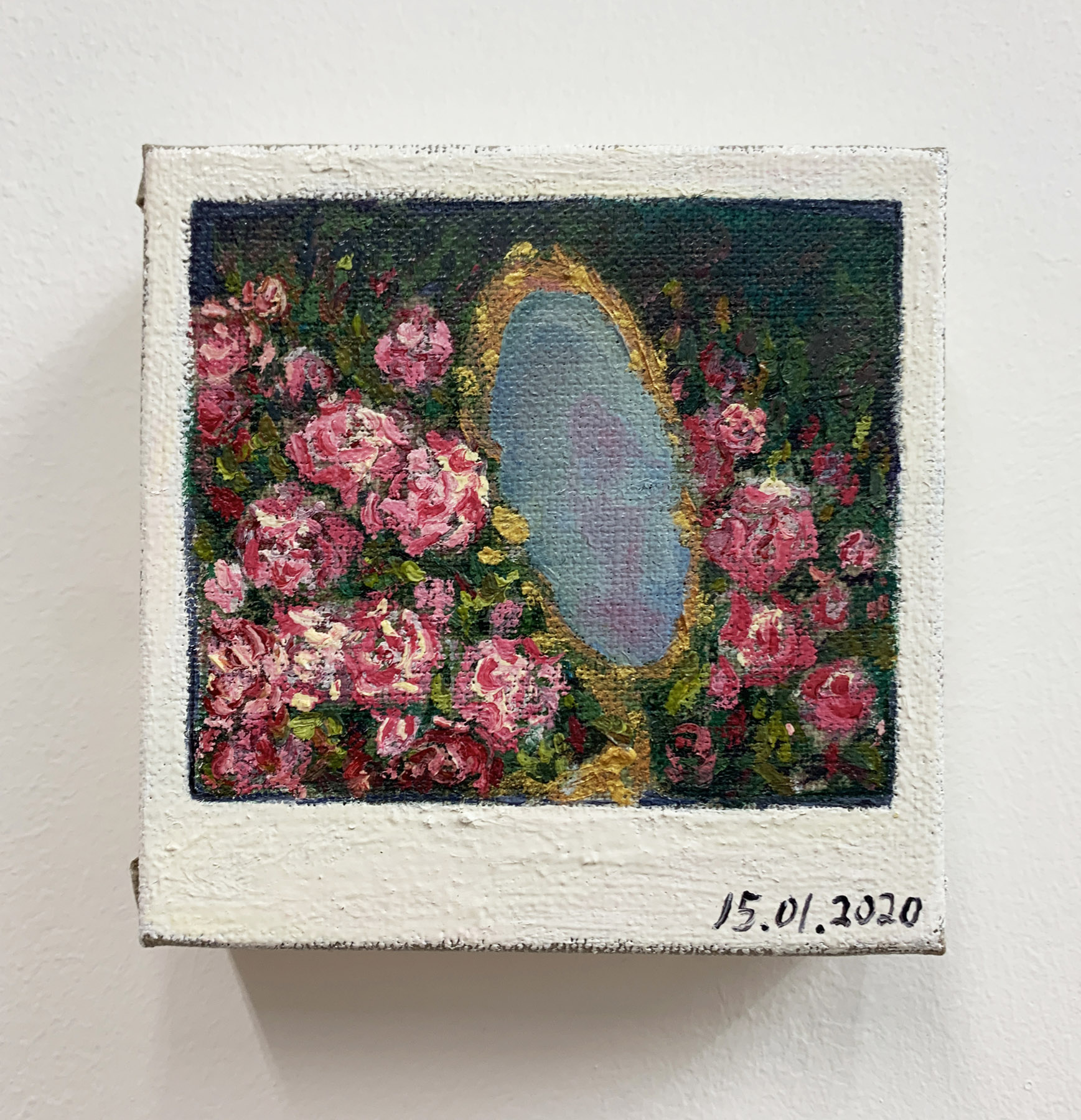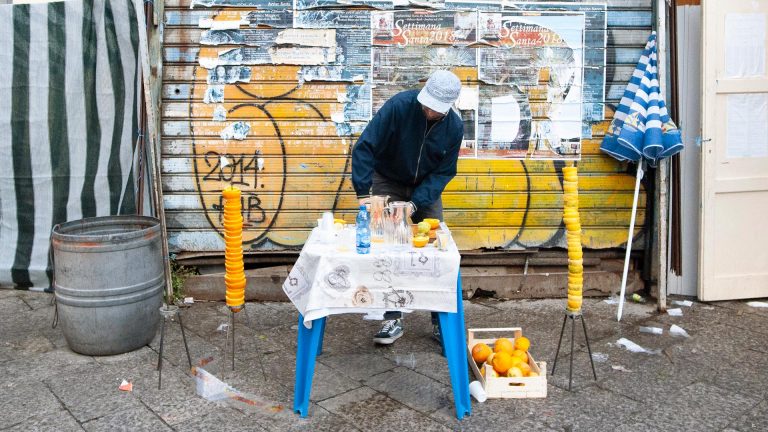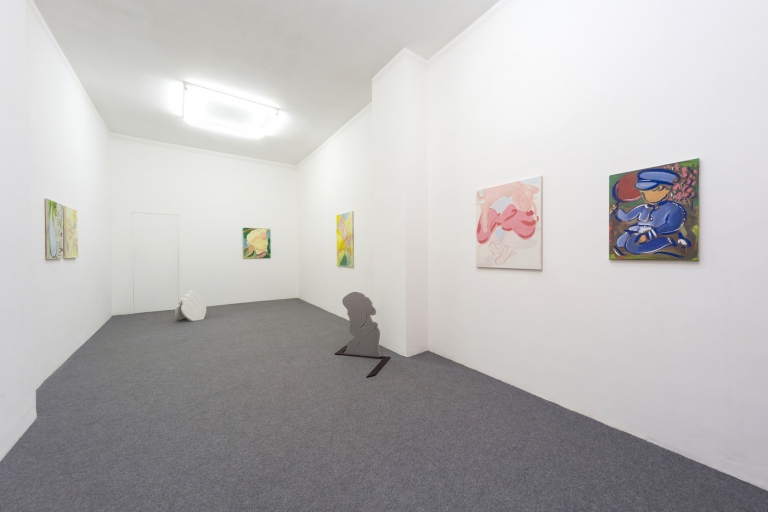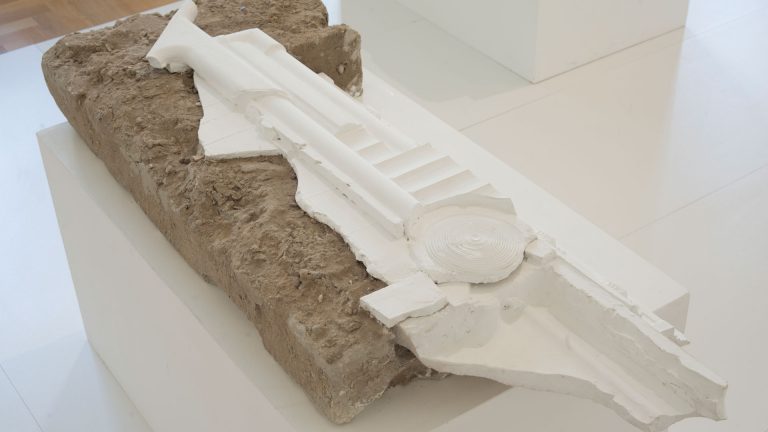Artists: József Csató, Maximilian Kirmse, Paul Heyer, Yeni Mao, Grace Woodcock, Yang Xu
Exhibition title: SOFTER SOFTEST
Curated by: Domenico de Chirico
Venue: Andrea Festa Fine Art, Rome, Italy
Date: November 1, 2020 – January 17, 2021
Photography: all images copyright and courtesy of the artists and Andrea Festa Fine Art, Rome
Andrea Festa is glad to announce the inaugural show of his own gallery titled “SOFTER SOFTEST” curated by Domenico de Chirico. The very first exhibition features works of six incredibly talented artists from all around the world: József Csató (b.1980 – Ungary); Maximilian Kirmse (b.1986 – Germany); Paul Heyer (b.1982 – United States); Yeni Mao (b.1971 – Canada); Grace Woodcock (b.1993 – United Kindom); Yang Xu (b.1996 – Cina).
According to the French philosopher Henri Bergson, who regarded Consciousness and World as unavoidably linked, the image can be considered a halfway entity between the “thing” and the “representation”, since it is «more than what the idealist calls representation, but less than what the realist calls thing». The object is an image «with its own identity», existing independent of the subject’s perception of it, by common sense. In this respect, you can speak of your own body as a source of action, capable of changing the order in which the other images are arranged; “matter” is then the aggregate of images, while “perception of matter” means that «these same images are referred to the eventual action of one particular image, my body». According to these precepts, Softer Softest refers to Bergson’s “picturesque object”, to that idea of a suspended and intangible image, the frame of a kinetic energy flux which therefore encourages it to present itself as extremely thin, the thinnest and softest of all scenarios, thus arriving at a vivid and waving conception of matter, evidently close to the results of the physics of time, which is then caught by our memory in a pragmatic way. Furthermore, in Softer Softest the subject-object division is regulated according to temporality, where memory, understood as duration, refers to an autonomy of the spirit, which in turn acts by extension on the body in the form of movement. And thus, each work shows a visual echo, a hint of a world that is not always tangible but rather a complex tangle of intentions and memories of this becoming.
The semantic and tactile roughness of József Csató’s work goes in harmony with the almost baroque evolution of the different ways in which the relationship between image and object, painting and matter is developed. Csató’s painting art is characterized by a sinuous truthfulness that seems to reproduce what is already represented, firmly reiterating, flaunting both the fairytale and the mythological iconography through figurative and abstract elements; in a world increasingly isolated and headed by algorithms, Paul Heyer’s pictorial works, highly allegorical, focus on the concepts of transiency, the complexity of reality and the transience of life, questioning what it means to be alive, exploring the limits of collective consciousness and bodily experience. The paintings are usually realized with a combination of acrylics and oil on canvas, known to be very different means of expression, however, with the result that the images, sometimes playful, turn out to be at the same time incandescent and brilliant, fluid and flat, traditional and absurd; Maximilian Kirmse, predominantly inspired in a creative way by the 1990s and modern Germany, is constantly looking for images and prosaic moments in a world apparently sparkling, that he makes timeless thanks to his painting art. Kirmse portrays a cartoon-like urban universe, sometimes provocative, through a pictorial technique that recalls pointillism, which is characterized by the use of an always bright yet dramatic light; strongly influenced by the theory and practice of modern architecture, Yeni Mao’s sculptures focus on issues of fragmentation, exploring the relationship between the subjective body and architecture through moderation, domination and absence. His work, a continuous dialogue with the vernacular of building systems, is the mean to answer the equations that continually emerge from the relationship between the body and the built environment; Mao challenges the perception of material, form and image in a fleeting and changing cultural context by constantly referring to what surrounds him; he works with the meaning of material production history and focuses on the aesthetic narratives arising from the alteration of the materials themselves; Grace Woodcock’s work is a response to the “depravity of touch”, a condition that arises from a minimal physical contact with other people: this condition is common in societies where physical contact is not part of everyday life, symbols of an imaginative world in which both waves and peristaltic reflections govern the way we experience act, desire, aesthetics, intimacy and creativity in the current reality. Woodcock’s layered sculptures, reminiscent of architecture, immediately and hiddenly bear in mind the bodily intimacy; starting from history and mysticism, Yang Xu’s work explores childhood fantasies and whims. Driven by the desire of rekindling the Rococo styles and sensibility found in her works, Yang skillfully paints contrived and unrepentant female figures in a sumptuous and extravagant style, in a unique show where light and dark meet continuously.
József Csató: (b.1980). Lives and works in Budapest. He studied at the University of Fine Arts Budapest (2000-2006). Solo exhibition: Deak Erika Galeria, Budapest (2019,2017); ENA Viewing Space, Budapest (2019); Schloss Esterhazy, Eisenstadt (2019); Lollypop Factory, Budapest (2019); Vunu Gallery, Kosice (2019); AQB Project Space, Budapest (2018); Virág Judit Gallery, Budapest (2016); ENA Viewing Area, Vienna (2015). Group exhibition: Public Gallery, London (2020); Deak Erika Galeria, Budapest (2019,2018, 2015); Krinzinger Projekte ,Vienna (2018); Parallel Vienna, Vienna (2017, 2016, 2015); Reproduced Paradise, Budapest (2016); Kunsthalle, Budapest (2015).
Maximilian Kirmse: (b. 1986). Lives and works in Berlin. He studied at the Academy of Visual Arts Leipzig, Meisterschüler (2015 – 2017). Solo exhibition: Philipp Haverkampf Galerie, Berlin (2019, 2017); Nino MIer Gallery, Los Angeles (2018). Group exhibition: Deichtorhallen Hamburg, Hamnurg (2020); Galerie Fiebach & Minninger, Cologne (2017); Galerie Tobias Naehring, Leipzig (2017); Kunstverein Tiergarten, Berlin (2017); Sans Titre, Paris (2016); Adler, Düsseldorf (2016); Kunsthalle Bozen, Italy (2016); Galerie Alexander Levy, Berlin (2015); Kunstraum Ortloff, Leipzig (2015).
Paul Heyer: (b.1982). Lives and works in Chicago. Nel 2009 he received his MFA in painting from Columbia Univesity. Solo exhibition: Night Gallery, Los Angeles (2019, 2016, 2013); Mickey, Chicago (2019); the Museum of Contemporary Art, Chicago (2018); Chapter NY, New York (2016, 2014). Group exhibition: Museum of Contemporary Art, Chicago (2020, 2017); Perrotin (2019); Park View/Paul Soto, Los Angeles (2017); Andrea Rosen Gallery, New York (2016); Shane Campbell Gallery, Chicago (2016); Rodeo Gallery, London (2015); Young Art, Los Angeles (2013); 356 Mission, Los Angeles (2015); Rachel Uffner Gallery, New York (2012).
Yeni Mao: (b. 1971). Lives and works in Mexico City and New York. He received a BFA from the School of Fine Art Istitute of Chicago and subsequently trained in foundry work in California and the architectural industries of New York. In 2020 he open a show at Fierman Gallery a New York, Brooke Bennington in London and Museo Tamayo in Mexico City. Solo exhibition: 2nd Street Gallery, Charlottesville (2015); Munch Gallery, New York (2014); Zidoun-Bossuyt, Luxembourg (2014); Flash Atöyle, Izmir (2013); Collette Blanchard Gallery, New York (2011); Chela Gallery, Baltimore (2004). Group exhibition: Hionas Gallery, New York (2014); Maquis Project, Izmir (2013); Munch Gallery, New York (2013, 2012); Station Independent Projects, New York (2013); Allegra LaViola Gallery, New York (2013); Mills Gallery, Boston (2013); Andrew Edlin Gallery, New York (2012); Ardell/DOB Hualamphong Gallery, Bangkok (2010); ROM for kunst og arkitektur, Oslo (2010); Rush Arts Gallery, New York (2009).
Grace Woodcock: (b. 1993). Lives and works in London. She studied at the Royal College of Art of London. Solo exhibition: Castor, London (2020); Hiato Project, Madrid (2020); SWG3, Glasgow (2018). Group exhibition: Museum of St Albans, Hertfordshire (2020); Castor, London (2020); Royal College of Art, London (2019); Chalton Gallery, London (2018); The Courtauld, London (2018); Guest Projects, London (2017); The Bear Club, Luton (2017); GENERATORprojects, Dundee (2017); Glasgow Print Studio, Glasgow (2017); Royal Scottish Academy, Edinburgh (2017); Blip Blip Blip, Leeds (2017); Whitespace Gallery, Edinburgh (2016); Assembly Roxy, Edinburgh (2016); Embassy Gallery, Edinburgh (2016); The Biscuit Factory, Edinburgh (2016).
Yang Xu: (b. 1996). Lives and works in London. She holds a First Class Honours BA in Painting from Wimbledon College of Arts and is currently attending an MA in Painting at the Royal College of Art (2018-2020). Solo exhibition: Barbican Arts Group Trust, London (2020); Central Saint Martins, London (2019); Deyin Hardware Head Office, ZiBo (2017); Yishu Gallery, ChangZhou (2017); City Milu Space, ChangZhou (2016). Group exhibition: Dock Street Studios, Dundee (2019); ArtWorks Project Space, London (2019); The Palace of Westminster, London (2019); Air Gallery, Manchester (2019); Bankside Hotel, London (2019); Roost Studios and Art Gallery, NYC (2019); NL Gallery, Beijing (2018); Royal Academy, London (2018); The Crypt Gallery, London (2018 – 2017); Wimbledon college of art, London (2018 – 2017); Anaglifos Art Gallery, Barcelona (2017).
SOFTER SOFTEST, 2020, exhibition view, Andrea Festa Fine Art, Rome
SOFTER SOFTEST, 2020, exhibition view, Andrea Festa Fine Art, Rome
SOFTER SOFTEST, 2020, exhibition view, Andrea Festa Fine Art, Rome
SOFTER SOFTEST, 2020, exhibition view, Andrea Festa Fine Art, Rome
SOFTER SOFTEST, 2020, exhibition view, Andrea Festa Fine Art, Rome
SOFTER SOFTEST, 2020, exhibition view, Andrea Festa Fine Art, Rome
SOFTER SOFTEST, 2020, exhibition view, Andrea Festa Fine Art, Rome
SOFTER SOFTEST, 2020, exhibition view, Andrea Festa Fine Art, Rome
SOFTER SOFTEST, 2020, exhibition view, Andrea Festa Fine Art, Rome
SOFTER SOFTEST, 2020, exhibition view, Andrea Festa Fine Art, Rome
Grace Woodcock, Sensory surrogate, Latex, spacer fabric, acupuncture needle, causticum, epsom salts, high – density upholstery foam, cnc routed foam, 2020, 54x39x9 cm
Grace Woodcock, The intimacy package, Latex, spacer fabric, neoprene – jersey, high – density upholstery foam, power mesh, cord, 2020, 29x25x14 cm
József Csató, Beach scene Acrylic, oil, ink on canvas, 2020, 175×150 cm
József Csató, Lost uncertainty, Acrylic, oil, ink on canvas, 2020, 187×190 cm
Maximilian Kirmse, Dinos 2, Oil on canvas, 2019, 160×190 cm
Maximilian Kirmse, R,E,F,, Oil on canvas, 2017, 160×130 cm
Paul Heyer, Apples on plaid, Oil, acrylic on polyester, 2020, 63,50×55,88 cm
Paul Heyer, Wow, Oil, acrylic on polyester, 2019, 63,50×55,88 cm
Yang Xu, Girl in the mirror polaroid 15012020, Oil on linen, 2020, 10×10 cm
Yang Xu, Mask 11102020, Oil on linen, 2020, 19,8×23,3 cm
Yang Xu, Rose petal 18102020, Oil on linen, 2020, 50×40 cm
Yeni Mao, Fig 25,4 Don’t you know the devil is a liar, Ceramic, steel, leather, acrylic paint, 2020, 56x61x16 cm
Yeni Mao, Fig 25,5 Copperhead, Ceramic, blackened and copper plated steel, leather, brick, 2020, 99x73x48 cm





























